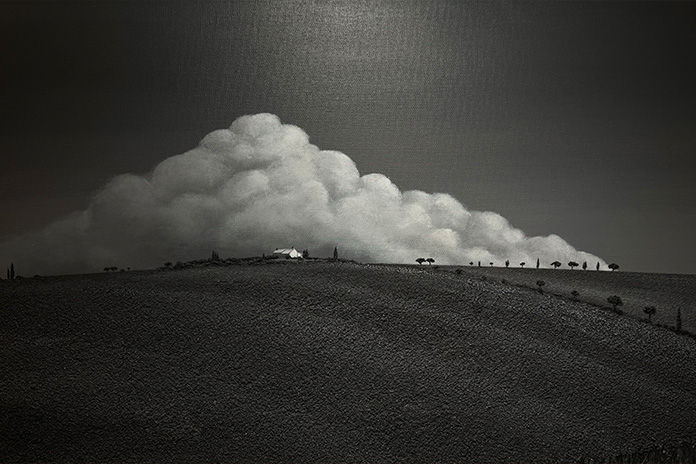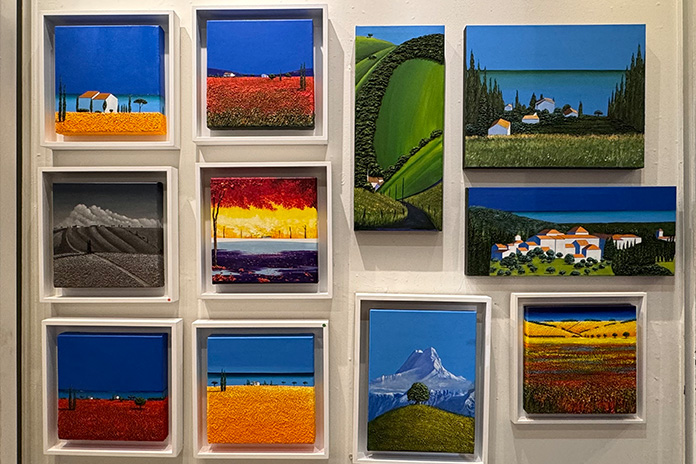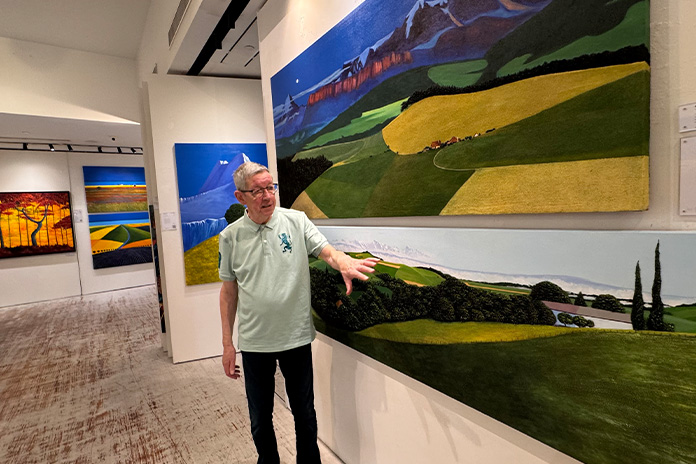ARTIST Ronnie Ford takes art almost to the molecular level.
His intricate landscapes are filled with little dots of sculpted acrylic paint that give greater depth to the works of art — be they small or large pieces.
Most of his works are of the French, Italian and Swiss countryside, presented in vivid colours to showcase the vibrance he observed upon discovering blue skies and textures and patterns outside of his native Scotland.
But, there must be something appealing about the greys of Scotland that turned his eye to monochrome works, albeit of the European landscape.
“The people love them,” he says, rather bemused at the reaction to his latest textured pieces.
Ronnie, whose exhibition, Meadows To Mountains, is currently ongoing at Ode To Art (odetoart.com) at Raffles City, Singapore, has, within this collection of new works, some monochrome pieces under the banner, Shades Of Grey.

How Many Shades Of Grey?
“And no, there aren’t 50 shades of grey,” Ronnie chuckles.
“There are around 30 shades,” he explains. At least as far as he knows.
Many of the monochrome pieces are set in the Val d’Orcia in Tuscany, and capture the textures and contrasts of the landscape — plowed, patterned patches against the vast cerulean with its chaotic clusters of clouds.
Adopting a Chinese master’s approach to painting — to focus on the story and the quality of the tone rather than be distracted by colour — the monochromes have proven popular and will likely remain an integral part of his oeuvre.
Like many artists, Ronnie started with watercolours, which he considers one of the hardest mediums to work with, before progressing to oil. But an allergy to the paints forced him to switch to acrylics, which were being introduced to the market then.
“I don’t have any problem with using acrylics. I can use my watercolour techniques and my oil painting techniques with the acrylics, so it’s just the perfect medium for me personally.”

Time Is Of The Essence
But Ronnie’s art requires more patience for the creator and collector.
“If I were to paint a landscape like most artists do, it would be done in a matter of 2 or 3 hours. Using my textural technique, we’re looking at anything up to two months to complete a piece because they need drying time. It’s a process that uses the skill of the sculptor as well as the painter because I’ve trained in painting and I’ve got a degree in sculpture, and I love both equally.”
While technique and being unique are good calling cards for an artist, Ronnie still believes in capturing the spirit of what he sees painted on the canvas.
“In art, I found the spirit of a place to be fascinating. Exploring the sheer scale of the fields and the valleys, the rolling countryside, the subtlety of the mist on the mountains.”

Asian Influence
Ronnie lived two decades in Hong Kong, where he taught art while continuing to paint. Things Asian have caught his attention, and he is now working on a series of paintings on Singapore, which should be part of his next exhibition.
In an increasingly sped-up world, Ronnie’s art allows for quiet contemplation and a calming of the senses. It encourages focus and concentration on one prevailing picture that occupies your vision, attention, and imagination.
Even as his art draws out the quieter side of the human condition — he doesn’t paint conflict — Ronnie does appreciate the advance of modern technology, even if he has yet to embrace it as much as he would like to.
ALSO READ: Shufen Goh On The Future Of Marketing
Art And AI
“I think artificial intelligence (AI) is a positive thing, though it’s frightening,” he admits.
“It’s just how quickly it can do things and how it can emulate things so easily. I liken it to the invention of photography.
“When photography was invented, in the late 1800s, the papers and all the media that existed then said, art is dead. They don’t need art anymore.
“But it didn’t kill art because the artists embraced photography. The artists said, this isn’t killing what I do.
“It’s giving me opportunities to do new things, to be free from being enslaved to doing portraits all the time, or just reproducing flowers accurately. I can now express something about them.
“And new art movements just flourished — Surrealism, Cubism, Fauvism, Impressionism.”
Ronnie draws parallels between photography and AI, and reckons that the fears people have of job losses and other negative reactions could be viewed through a different lens.
“A lot of people are frightened of AI at the moment, but I think when you see its potential and how it can be embraced to enrich what they’re doing, to be free to do something different, it will become accepted and people will love it just as much as they do everything else.”
Maybe AI could one day be instructed in textural painting to deliver precise renditions of Ronnie’s ideas.



















